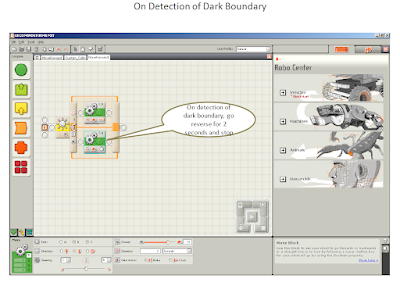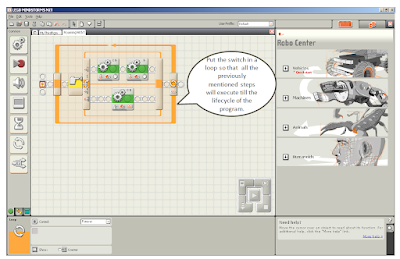Here is a small clip showing the Line Follower performance and the LeJOS code associated with it. The robot here is the small car which is built using small booklet provided with NXT kit. The LeJOS firmware for NXT can be downloaded and installed on the NXT brick from LeJOS NXJ 0.9.1. The design of my Java program is heavily influenced by the Line Follower in the book "Programming Lego Mindstorms with Java" by Giulio Ferrai et all. The actual algorithm to follow the line is influenced by Jacek Fedorynski's Line Follower NXC program. The LeJOS program has four classes: LFJfedor, Cruiser, LFUtils and LineValueHolder. The LFJfedor class contains the main method and is the starting point of the program. This class initializes the light sensor and calibrates the sensor for Black and White values in its constructor. The black and white values are stored inside a Java Bean called LineValueHolder. LFJfedor class also starts the thread Cruiser. The Cruiser class has the algorithm to follow the line, given the calibrated black and white values and the light intensity at any given point in time. LFUtils class calculates the average light intensity over 20 samples, at any given point of time. The average over 20 points is calculated in order to smoothen out the spikes in the light intensity (if they exist). Let me explain some of the program details below.
In order to calibrate the threshold for White, the NXT brick beeps twice. It prints the message "white" on the screen of the NXT brick. The user is supposed to keep the light sensor on the White part of the line follower chart and press the ESCAPE button. This process will record the White light intensity in the Java Bean LineValueHolder. Similarly, record the Black value when the NXT beeps twice again. It prints the message "black" on the NXT screen. The user is supposed to keep the light sensor on the black strip of the line follower chart and press the ESCAPE button. This process will record the Black light intensity in the Java Bean LineValueHolder. Once the White and Black intensities are recorded, the Line Follower program works as follows:
- The Line follower follows the edge of the line where the threshold value is (Black + White)/2
- The instantaneous value of the light is calculated by averaging over 20 light samples
- The B Moter and C Moter is powered in proportion to the difference between the threshold and the instantaneous value of light (defined by the variable "color")
- The initial value of power = 22 and the constant multiplier 50 requires few attempts to be set correctly in order to follow the line, in a certain speed
I wish you enjoyed the article!



















